- Home
- Terry Pratchett
Mrs Bradshaw's Handbook (Discworld Novels) Page 3
Mrs Bradshaw's Handbook (Discworld Novels) Read online
Page 3
On a personal note I was pleased to see that the Fish and Chip Shop in Three Roses Alley is still there. When I was a girl at the college, this was a favourite haunt for many of us, not least because of the handsome young man working behind the counter. I would imagine the good-looking man now in charge is his son.
La Sorbumme, the Fools’ Guild summer school and retirement home, is located in the old part of the city adjacent to the site of the collapsed tower. Impromptu and noisy entertainments by silly old fools create quite irksome street theatre in this district and the liberal distribution of banana skins and custard pies may well be the death of some of the elderly folk who have retired here for a quiet life.
It is worth noting that the City Assembly has laid down strict licensing laws. Bars are closed on Octeday and during the rest of the week they normally close before 10.00 in the evening. Quirm is indeed an agreeable city for a vacation, convalescence or retirement.
As yet the seafront is unspoiled and the sandy beaches and little offshore islands are the main attraction of the resort.
Before laying down your picnic blanket on the beach, check for clumps of a kind of seaweed known locally as snapping bladders. This vicious plant, which can move very quickly, will bite the unwary and maliciously kick sand in your picnic. Beware also the shoals of trifle fish that shoot a stream of viscous yellow liquid from their trailing tentacles, which is an annoyance to beachgoers but collected and prized by some Quirmian chefs.
3
THE RAILWAY LINE extends from Quirm City to the coast, where it turns back towards Ankh-Morpork via a slow but scenic route. At present the only way to travel further turnwise to Llamedos and beyond is by road or boat. Delays in completing the bridge over the Quire are not the only reason for this. It seems that the city council in Pseudopolis (mainly small shopkeepers with vested interests) assert they ‘will have no Ankh-Morpork Kettle fouling their air, frightening their horses and discolouring their sheep’s fleeces’. However such is the demand for travel turnwise the AM&SPHR is planning to run a line through the small fishing port of Soarmouth, some miles from Pseudopolis City.
The first stop on the coastal line is the resort of Quiremouth, once a small fishing village, but now becoming a popular day-trip destination. In the summer this train is filled with children clutching buckets and spades, shrimping nets and miniature harpoons; their harassed parents laden with picnic baskets, towels and folding chairs.
There are a few freshly painted guesthouses opening up along the seafront and stalls selling winkles, banged grains and a strange, sticky confection which looks like a small colourful cloud, its tacky stain evident on the faces and hands of anyone eating it. People do behave in a different way at the seaside: gentlemen roll up their trousers and paddle like small children, while staid matrons, along with giddy girls in service, sport broad-brimmed hats embroidered with a message demanding that they be kissed, and quickly. Troll nannies, slightly comatose from the heat, smile benignly at their charges as they allow sand to be heaped up over their bodies. I have even seen a few dwarfs remove their headgear and expose their bearded faces to the sun. There must be a residual magic in that strand between land and sea.
•QUIREMOUTH•
POPULATION: 120
CLACKS TERMINAL: on the quay.
ACCOMMODATION: Harbour Hotel, Ship Inn.
MARKET: Early morning fish market on the quay.
A small fishing village and seaside resort on the Quire estuary.
THE SLOW TRAIN from Quiremouth meanders its way rimwards following the contours of the coast, making occasional stops to take on consignments of fish. Glimpses of blue sea are interspersed with stands of pine trees. On the landward side there are acres of vineyards which produce the famous wines of the region.
The wine makers who live along the coast take advantage of the brief halts where the engine is refuelled or fish is taken on to load their cases of wine into the goods van for delivery to Ankh-Morpork. More often than not, a bottle of their best vintage and a few glasses find their way into the passenger compartments for a spot of impromptu wine-tasting.
The three-hour journey passes in no time and most travellers are well fortified by the time the train approaches the great steaming swamps of the Netherglades. There is something threatening about this lush green landscape; from the train one can hear raucous birdsong and the buzzing of a thousand mosquitoes – even the sound of train on track changes from clickety clack to thippety thapp – and the ground trembles as the train passes. Constructing the railway around this area was one of the most difficult engineering challenges of the whole route and it is easy to understand why. Dry land is hard to find anywhere.
A report from one of the surveyors working on the project sheds more light on the Netherglades.
LEAVING THE NETHERGLADES the train travels hubwards and resumes its normal speed and rhythm; the climate becomes more temperate and grassy fields dotted with trees extend in every direction. In little over an hour the outskirts of Shankydoodle come into view.
Here white-painted picket fences delineate the fields, and grand mansions with stable yards are much in evidence.
I was told by a fellow traveller, wearing highly polished elastic-sided boots, a tweed jacket over a scarlet waistcoat, and a yellow silk cravat, that Shankydoodle is the most important centre of race-horse breeding in the world; it is from these stud farms that some of the finest thoroughbreds have emerged, including the famous Klatchian Star who won every race he entered until he fell at Hitcher’s Ditch and was dispatched to a useful afterlife courtesy of Clancy & Son Pet Supplies.
The station at Shankydoodle is large and well kept, a reflection of the wealth of the inhabitants and the popularity of the racetrack which, thanks to the railway, now draws in thousands of people from as far away as Ankh-Morpork and Quirm.
•SHANKYDOODLE•
POPULATION: 295
CLACKS TERMINALS: at the railway station and the racecourse.
POST OFFICE
ACCOMMODATION: The Turf Club, The White Horse Inn, Captain Pepper’s Inn.
BANK: Royal Bank of Ankh-Morpork.
Annual horse fair and horse yearling sales in April.
This area is celebrated for its horse-racing and is also a centre of specialist medical excellence. The small cottage hospital has an Igor who can repair the most complex limb fractures and spinal injuries in both man and horse. NB His stock of spare parts is strictly segregated.
EVEN IF ONE is not a follower of the turf, Shankydoodle is a pleasant place to stay. There are several scenic walks through the parkland and it is worth getting up early to see the horses at the morning gallops. One can hear the thunder of their hooves before they emerge from the dawn mists in a rush of speed. Exhilarating indeed.
On race days there is an air of anticipation and excitement in the town. The jostling crowd is a mixture of the wealthy (well-dressed owners in conversation with trainers and jockeys) the hopeful (serious-looking men wearing flat caps and binoculars, intent on their racing paper) and the desperate, those to whom a flutter on the races has, over the years, turned into more of a forlorn flapping with serious consequences to their personal finances. And of course there are day-trippers with a few dollars to risk on the favourite runner. Since gambling is frowned upon in the dwarf fraternity few are in evidence here. On the other hand trolls have embraced the turf with some enthusiasm and troll consortiums now own several racehorses. They have also embraced racing fashions and what appears, at first glance, to be a large, brightly checked tweed marquee is likely to be one or more trolls checking out their investments.
Trolls have brought more than just their huge size and sartorial dash to the turf as is revealed in the attached cutting from the Shankydoodle Racing Times.
THE RACECOURSE BENEFITS from a rather fine and somewhat elaborate tote board, originally designed as a five-year desk diary, almanac and appointment device by Bloody Stupid Johnson. Unfortunately its size of over twenty feet by thirty made
it impractical and the dates were never correct. The giant device was discovered in a barn close to the racetrack and was renovated by a family of goblins while they lived within its complex interior. With their cooperation the contraption was eventually erected at the main entrance to the viewing paddock where it now displays the time of the races, names of runners and jockeys, the changing odds and for some reason the phases of the moon and high tide in Quirm. It is much admired.
Don’t leave Shankydoodle without sampling the local brew, Mudstone’s Peculiar, a robust porter made using water from the Netherglades which gives substance to its rich darkness.
The journey continues hubwards, the train passing through a landscape of pasture and woodland to the usual delays at Champal Junction where it rejoins the main line to Ankh-Morpork.
I once asked Mr Lipwig why the train did not continue back to Ankh-Morpork via the coast. Part of the reason was the difficulty of laying more track through the Netherglades. But the other reason is more curious. Apparently a rival company decided to run a railway along the Circle Sea coast and build a modern holiday resort there. They made good progress for the first hundred or so miles. But then the trouble started and it was reported that workmen on the dawn shift found several pretty girls in filmy clothing tied down to the track who, as the mists lifted, seemed to melt away. There were rumours that these were girls from the Pink Pussycat club, in the pay of the AM&SPHR. Mr Lipwig said he could not possibly comment and that everyone knew the old legends about a place called Holy Wood where a great city disappeared into the sand overnight.
*
FROM DIMMUCK A single-track branch line extends hubwards to Scrote and the Effing Forest. The train has just one carriage for passengers, the rest being flatbed trucks or wagons to transport timber from the forest.
I am told that Scrote hasn’t changed much even with the arrival of the railway. A narrow stone building serves as the station master’s office, the upper floor acting as a signal box.
LEVEL AND UNLEVEL CROSSINGS
AT THE POINT where the railway meets one of Scrote’s two roads the right of way across the junction is governed by a level crossing. Gates close off the track from the road traffic until a train is approaching, when a bell rings in the station master’s office, prompting him to move the gates to bar the road and allow the train free passage.
The system works well here, but elsewhere, according to the guard on the train, the rumour that the purpose of the gates was to indicate a request stop has caused some minor injuries as well as disappointment. Large signs have now been erected at all level crossings explaining their purpose.
By an accident of geography (or maybe because the surveyors were guests of the hospitable landlord of the Pickled Cabbage pub near Sto Kerrig), one section of railway track on the Sto Kerrig branch line was laid through the Pickled Cabbage’s yard, and a level crossing installed. Reuben Sticky, the said landlord, was planning to make sure the gates closed off the track at meal times, thus causing unscheduled stops for the passengers but a lucrative business for himself. What he actually got was a fine from the railway company who then replaced the gate with a permanent structure. His dismayed regulars now have to put up with the noise and smoke of the trains and the additional inconvenience of the conveniences being the other side of the track.
There is also a story about an engine driver in Ohulan Cutash. He was faced with the conundrum of either disobeying company regulations about road crossings where he should sound his whistle on the approach, or encountering the wrath of his old granny who lived near by and said the noise was enough to wake the dead let alone her and her cat. Apparently he made arrangements with local goblins who, when they see his train approaching, flash with mirrors or lamps to another of their number who deals with the gate.
After Scrote the landscape becomes more wooded, and in less than half an hour the train terminates at Effing Halt deep in the bosky shadows of the Effing Forest. There is a well-constructed wooden station and gantries for loading timber and also coal from the small, family-run mines. A plaque on a dented anvil within the station commemorates Jed and Crucible Wesley, local pioneers in the field of steam power for one short, abruptly ended day.
•EFFING HALT•
POPULATION: 41
CLACKS TERMINAL
This stop primarily serves the local logging industry. Most travellers stay in Scrote.
THIS ANCIENT WOODLAND is home to some interesting flora and fauna: details are recorded in a pamphlet distributed by the Friends of the Effing Forest. This body is now campaigning to save the Effing Great Tit, whose nesting sites are apparently endangered by the greatly increased level of tree-felling. I was shown a copy of a letter they have sent to the railway pleading their cause.
The Effing Forest is also home to lumberjacks who, it is reported, are often the worse for drink, a most unfortunate condition for young men whose livelihood depends on the axe. Unsurprisingly, there is an Igor Rapid Response Unit based at The Forester’s Arms, where impromptu entertainment is sometimes provided by the lumberjacks who have formed a rustic and somewhat energetic choir.
Tucked away in a glade a mile or so from the station is a shrine to Sweevo, the God of Cut Timber. It takes the form of a carved pine totem pole about twenty feet high and it is still regularly visited by the local woodcutters. There is a superstition that bad luck will follow if a woman witnesses any of the ceremonies surrounding Sweevo. It has been reported that since the arrival of the Igors the offerings of severed limbs have been replaced with carved wooden representations of the same.
4
THE SINGLE-CLASS STOPPING train to Big Cabbage leaves from platform 2 of New Ankh Station. This country train is very friendly; everyone seems to know everyone else, as they clamber on at the stations along the line, armed with shopping bags and baskets for the journey to market, or going to see family and friends in the surrounding towns and villages. There are a good number of trolls, generally travelling in their own open carriage, on their way to visit their families in the new housing estates in Sunink. What were once small villages on the outskirts of the city have expanded into suburbs so that the view from the train is rows and rows of new houses which fill the gaps between the old farm buildings. There is a certain similarity to all these houses and it appears that builders will erect a row of dwellings in a week and sell them by the weekend and even arrange for the goods and chattels of the new owners to be delivered by cart before the ink is dry on the contract. Such is the competition between builders that they employ a number of trolls to walk beside the track with huge sandwich boards offering property for sale.
*
About half an hour after leaving Ankh-Morpork, the train stops at the township of Upunder. This once typical Sto Plains community is now home to many families who have moved out from Ankh-Morpork to enjoy the bouquet of the cabbage-enriched air.
•UPUNDER•
POPULATION: 550
CLACKS TERMINAL
POST OFFICE
ACCOMMODATION: Keevil’s Hotel, The Boot Inn.
MARKET DAY: Wednesday.
Squash Monday Fair, third Monday in June, marks the start of the caterpillar eradication season.
UPUNDER IS A small but expanding town with a tradition of cabbage-growing and cobbling. The Offle King cabbage thrives here and its robust outer leaves provide sustainably produced soles for the practical and hard-wearing Upunder boot, which to generations of farmers has meant the difference between being dry-shod and suffering from Squelch, a nasty fungal affliction brought about by spending one’s working life with damp feet amid rotting vegetable matter. Now it seems that some young people have taken to wearing these boots as a fashion accessory, which has led to a trade in inferior imported boots using a cheaper leaf. These are reported to smell dreadfully when wet; so much for progress and the vagaries of fashion.
THE ENDLESS FIELDS of brassica stretch in every direction with a sameness that might be restful were it not for the overwhelming odour of
the cabbage. An hour after leaving Ankh-Morpork the city of Sto Lat appears on the horizon perched on its rocky outcrop like a fortress island on a sea of bilious green. This ancient kingdom had until the coming of the railway more history than future, and is ruled by Her Supreme Majesty Queen Kelirehenna I, Lord of Sto Lat, Protector of the Eight Protectorates and Empress of the Long Thin Debated Piece Hubwards of Sto Kerrig. She has been most forthcoming in her views as to the benefits of the railway to a small kingdom built on the fortunes of leaf vegetables, and was behind the building of the modern terminus outside King Olerve’s Gate. It is constructed to look in keeping with the surrounds by employing the artifice of crenellated towers and what appears to be a huge portcullised gate that is in fact the entrance to the engine sheds. Sto Lat Junction, to give it its official name, forms the centre of a network which extends as far hubward as Uberwald, and the great engine sheds and workshops of Swine Town lie near by.
•STO LAT•
POPULATION: 9,800
CLACKS TERMINAL AND GRAND
TRUNK OFFICE
POST OFFICE
ACCOMMODATION: The Queen’s Head, The Railway Hotel, The Runcible Arms, The Plough Inn.
BANKS: The Cabbage Growers’ Cooperative, Apsley’s Commercial.
MARKET DAYS: Wednesday and Saturday.
Grand Agricultural Show in May, Soul Cake Duck Parade in Sektober, Cabbage Scramble and Rolling contest in Ick.
STO LAT IS the commercial centre of the cabbage-growing business and boasts the Grand Brassica Exchange Building as well as the Rutabaga Assembly Halls. The Josiah Remnant mural in the latter is reported to be his largest rendition of Prospect of Sprouts Upon a February Morning.

 Feet of Clay
Feet of Clay The Color of Magic
The Color of Magic Thud!
Thud! Good Omens: The Nice and Accurate Prophecies of Agnes Nutter, Witch
Good Omens: The Nice and Accurate Prophecies of Agnes Nutter, Witch I Shall Wear Midnight
I Shall Wear Midnight Mort
Mort Raising Steam
Raising Steam Guards! Guards!
Guards! Guards!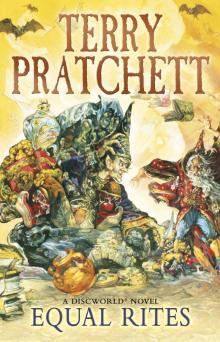 Equal Rites
Equal Rites A Hat Full of Sky
A Hat Full of Sky The Light Fantastic
The Light Fantastic Mrs Bradshaw's Handbook
Mrs Bradshaw's Handbook Wyrd Sisters
Wyrd Sisters Soul Music
Soul Music Small Gods
Small Gods Sourcery
Sourcery Reaper Man
Reaper Man Night Watch
Night Watch Lords and Ladies
Lords and Ladies The Fifth Elephant
The Fifth Elephant Monstrous Regiment
Monstrous Regiment The Truth
The Truth Witches Abroad
Witches Abroad Eric
Eric Going Postal
Going Postal Men at Arms
Men at Arms Jingo
Jingo The Amazing Maurice and His Educated Rodents
The Amazing Maurice and His Educated Rodents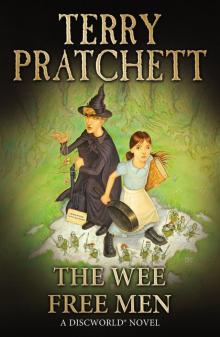 The Wee Free Men
The Wee Free Men Pyramids
Pyramids Wintersmith
Wintersmith Moving Pictures
Moving Pictures Carpe Jugulum
Carpe Jugulum Interesting Times
Interesting Times Maskerade
Maskerade Making Money
Making Money The Shepherd's Crown
The Shepherd's Crown Hogfather
Hogfather Troll Bridge
Troll Bridge The Last Continent
The Last Continent The Sea and Little Fishes
The Sea and Little Fishes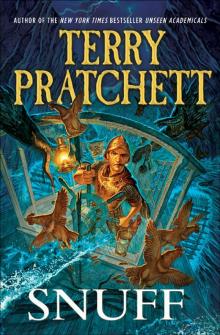 Snuff
Snuff Unseen Academicals
Unseen Academicals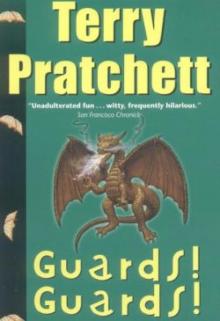 Guards! Guards! tds-8
Guards! Guards! tds-8 Jingo d-21
Jingo d-21 Turtle Recall: The Discworld Companion ... So Far
Turtle Recall: The Discworld Companion ... So Far The Fifth Elephant d-24
The Fifth Elephant d-24 Discworld 39 - Snuff
Discworld 39 - Snuff The Long War
The Long War Only You Can Save Mankind
Only You Can Save Mankind The Science of Discworld III - Darwin's Watch tsod-3
The Science of Discworld III - Darwin's Watch tsod-3 A Blink of the Screen: Collected Short Fiction
A Blink of the Screen: Collected Short Fiction Unseen Academicals d-37
Unseen Academicals d-37 Wings
Wings Making Money d-36
Making Money d-36 A Blink of the Screen
A Blink of the Screen Johnny and the Bomb
Johnny and the Bomb Dodger
Dodger Strata
Strata Discworld 02 - The Light Fantastic
Discworld 02 - The Light Fantastic The Folklore of Discworld
The Folklore of Discworld The Science of Discworld
The Science of Discworld The Unadulterated Cat
The Unadulterated Cat Raising Steam: (Discworld novel 40) (Discworld Novels)
Raising Steam: (Discworld novel 40) (Discworld Novels) The World of Poo
The World of Poo Discworld 05 - Sourcery
Discworld 05 - Sourcery The Witch's Vacuum Cleaner: And Other Stories
The Witch's Vacuum Cleaner: And Other Stories The Science of Discworld II - The Globe tsod-2
The Science of Discworld II - The Globe tsod-2 Small Gods: Discworld Novel, A
Small Gods: Discworld Novel, A Men at Arms tds-15
Men at Arms tds-15 Tama Princes of Mercury
Tama Princes of Mercury The Last Hero (the discworld series)
The Last Hero (the discworld series) The Long Utopia
The Long Utopia Discworld 03 - Equal Rites
Discworld 03 - Equal Rites Terry Pratchett - The Science of Discworld
Terry Pratchett - The Science of Discworld The Long Earth
The Long Earth The Carpet People
The Carpet People The Sea and Little Fishes (discworld)
The Sea and Little Fishes (discworld)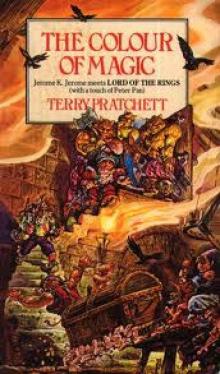 The Colour of Magic
The Colour of Magic Discworld 16 - Soul Music
Discworld 16 - Soul Music The Long Cosmos
The Long Cosmos The Dark Side of the Sun
The Dark Side of the Sun Monstrous Regiment tds-28
Monstrous Regiment tds-28 The Bromeliad 3 - Wings
The Bromeliad 3 - Wings Dragons at Crumbling Castle: And Other Stories
Dragons at Crumbling Castle: And Other Stories Night Watch tds-27
Night Watch tds-27 The Science of Discworld I tsod-1
The Science of Discworld I tsod-1 The Bromeliad 1 - Truckers
The Bromeliad 1 - Truckers The Science of Discworld Revised Edition
The Science of Discworld Revised Edition The Abominable Snowman
The Abominable Snowman Father Christmas’s Fake Beard
Father Christmas’s Fake Beard The Bromeliad Trilogy
The Bromeliad Trilogy A Slip of the Keyboard
A Slip of the Keyboard The Wee Free Men d(-2
The Wee Free Men d(-2 Johnny and the Dead
Johnny and the Dead Mrs Bradshaw's Handbook (Discworld Novels)
Mrs Bradshaw's Handbook (Discworld Novels) Truckers
Truckers The Amazing Maurice and His Educated Rodents d(-1
The Amazing Maurice and His Educated Rodents d(-1 Diggers
Diggers Thief of Time tds-26
Thief of Time tds-26 Science of Discworld III
Science of Discworld III Dragons at Crumbling Castle
Dragons at Crumbling Castle Nation
Nation Darwin's Watch
Darwin's Watch Interesting Times d-17
Interesting Times d-17 The Bromeliad 2 - Diggers
The Bromeliad 2 - Diggers The Science of Discworld II
The Science of Discworld II